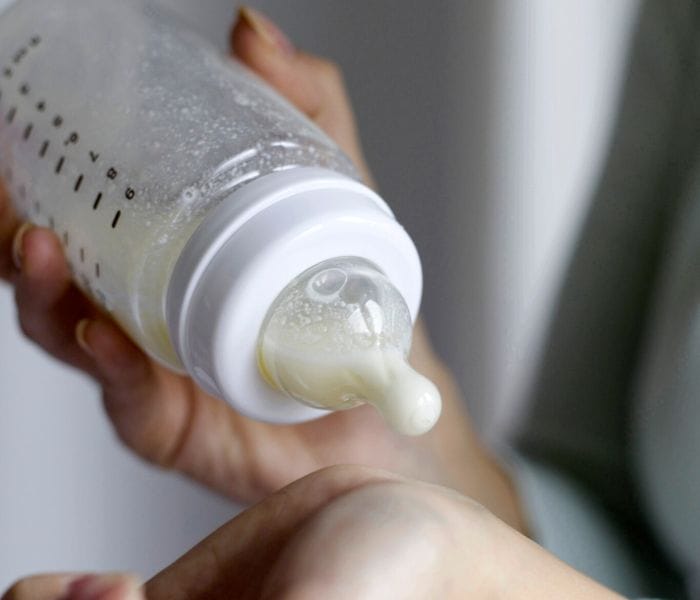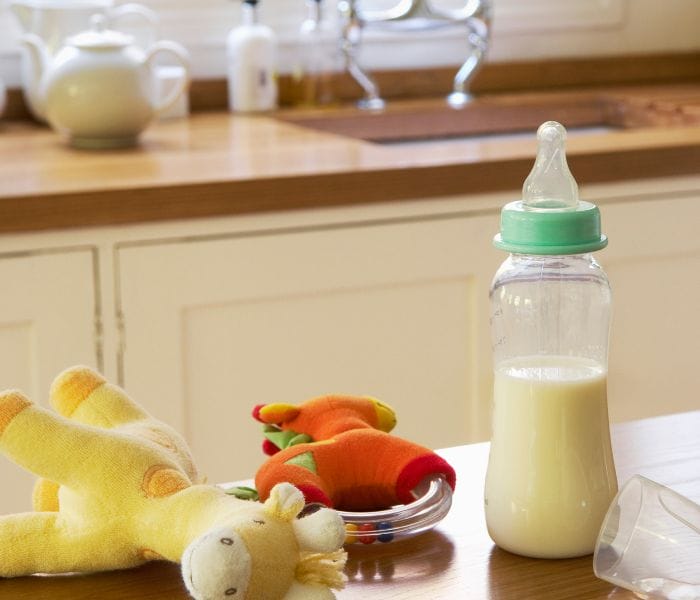Seeing a typical breastfeeding schedule for your newborn can feel overwhelming at first, but understanding what to expect is one of the best ways to support your baby’s growth and your own peace of mind. In the early days, feedings are frequent and unpredictable, but with time and consistency a rhythm will emerge.
I am a mom of 3, who exclusively breastfed my singleton. I am also a twin mom who understands how helpful a good schedule and routine is when you have little ones to care for. This post will guide you through what a typical newborn breastfeeding schedule looks like, how often to feed, and my top tips to getting through this very busy and exhausting time as easily as possible.
Please note, there are affiliate links in this post. Read my privacy & disclosure policy at the bottom of this page to learn more.
Sample Newborn Breastfeeding Schedule (How Often Newborns Nurse)
When your baby is a newborn (up until around 6 weeks old), you will feed him or her on demand. During the newborn stage, your baby will need to feed 10-12 times per day! To get a better understanding of what this will look like, check out the sample breastfeeding schedule for a newborn below.
TIME | DESCRIPTION |
8am | Nurse 20-40 min |
11am | Nurse 20-40 min |
1:30pm | Nurse 20-40 min |
4pm | Nurse 20-40 min |
6:30pm | Nurse 20-40 min |
8pm | Bedtime feeding |
10:30pm | Night feed |
1am | Night feed |
4am | Night feed |
6am | Dream feed & back to bed |
Related: This bundle of printable Baby’s First Year Schedules & Logs helps reduce new parent overwhelm and includes a newborn breastfeeding schedule. It contains many different sample schedules and trackers from newborn through the first year.
How To Count the Time Between Nursing Sessions
Unfortunately, the time between feeding sessions starts when your baby begins eating. It is NOT when your baby is finished nursing.
With a newborn baby needing to eat every 2-3 hours, this means if your baby takes 40 minutes to nurse and then needs to eat again after 2 hours, you might only have about an 80 minute break before you need to breastfeed again.

Tips for Surviving the Intensity of a Newborn Breastfeeding Schedule
Even though breastfeeding a newborn requires a pretty crazy schedule, the good news is it’s not permanent. As your baby gets older, nursing will get easier and happen less often. In the meantime though, check out the tips below to make this short period of time (even though it seems long now) go as smoothly as possible.
1 – Track Feedings
Track feeding times, duration, and which side you nursed on to stay organized. Use this printable Breastfeeding Log, so you never lose track.
2 – Understand the Schedule
Watch for hunger cues like rooting, sucking, or hand-to-mouth movements rather than waiting for a strict time. If it’s been 3 hours since the last feeding, you can offer your breast.
At night, it’s okay to let your newborn sleep longer if it happens. But, I don’t recommend going more than 4 hours, check with your pediatrician for more guidance though. Following a loose schedule gets your newborn into a rhythm sooner rather than later.
3 – Learn What a Good Latch Is
Learn here how to get a good latch. Ensure your baby’s lips are turned outward when nursing. It’s especially important to check the bottom lip.
Your baby’s bottle lip is harder to see when nursing and because of this it is more likely to not be positioned correctly. A good latch allows your baby to drink more efficiently and prevents mom from getting nipple cracking and breast engorgement.
4 – Use a Breastfeeding Pillow
I found a nursing pillow incredibly helpful during the newborn stage because your baby’s head needs to be supported and it helps with positioning your baby appropriately. It also gives support to mom and helps her maintain good posture.
This breastfeeding pillow was my favorite. I have two floors in my home and found it easier to have one nursing pillow upstairs for nighttime and one downstairs for daytime.
5 – Create a Designated Nursing Area in your Home
Having a familiar place you always feed your baby, can help your newborn settle in a routine more quickly. Additionally, quiet surroundings can help your baby focus and latch more easily. For you as a mom, it’s nice to have a nursing station with everything you need in one place.
6 – Offer Both Breasts
Start with one side, then offer the other to ensure your baby gets enough milk. For your next session, start on the breast you didn’t start on in the previous nursing session. This will keep your milk supply balanced in each breast.
7 – Pump When You Need To Be Away From Your Baby
It’s okay to pump if you need to be away from your baby. Just make sure any nursing sessions you miss, you replace with pumping.
Related: Learn what a combined nursing and pumping schedule looks like.
8 – Stay Hydrated & Nourished
Your milk supply depends on you taking care of yourself too. Drink plenty of water throughout the day and make sure you are eating balanced meals.
9 – It Will Eventually Get Easier
Nursing sessions take a LONG time during the newborn phase. But as the weeks pass, both you and your baby will learn how to breastfeed more efficiently. As time goes on, your baby will drink more quickly, sessions will get shorter, and there will be more time between nursing sessions.
10 – Don’t Be Afraid To Get Help from a Lactation Consultant
If you are struggling, it can be very beneficial to seek the help of a lactation consultant. I recommend doing it sooner rather than later, so you can address any breastfeeding struggles you are having.
Related: For more help, check out these breastfeeding and pumping tips for new moms.
Understanding a typical newborn breastfeeding schedule goes a long way in making your life as a nursing mom easier.
Breastfeeding a newborn takes time, patience, and flexibility. Every baby is different, and it’s okay if your routine doesn’t look exactly like the sample schedule above.
This schedule is a guideline to help you understand what to generally expect. The key is to follow your baby’s cues while gradually building a rhythm that works for both of you.
With consistency and support, breastfeeding will become a smoother, more manageable part of your daily life. And as your baby gets older feedings will be quicker and less frequent. Good luck mama, you got this!






